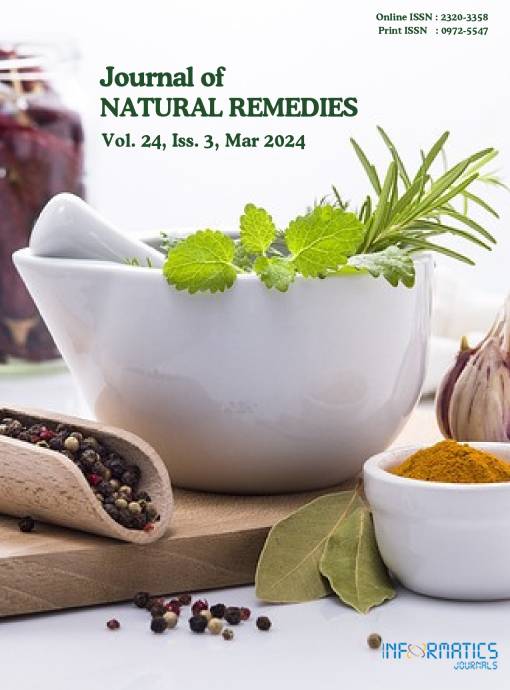Safety and Prescription Trends of Rasa Aushadhis (Ayurveda Herbomineral Formulations): A Critical Appraisal of Reported Medical Practices from CCRAS Experience
DOI:
https://doi.org/10.18311/jnr/2024/34139Keywords:
Ayurveda, Herbomineral, Metal and Mineral, Prescription Trends, Rasa AushadhisAbstract
Background: In Ayurveda, metal and mineral-based formulations are popularly practised for their pleasant applicability and first-rate potency. There is no doubt about the safety and potency of Ayurveda Rasa Aushadhis if they are prepared and used as per the terms mentioned in the literature. For the globalisation of Ayurveda, safety and efficacy with quality control have become important affairs for the scientific presentation of truth/reality. The present study was undertaken to document and analyse the information from clinical records about gross safety and prescription trends of different Ayurveda Rasa Aushadhis. Methodology: Primary data collection was performed from 24 clinical centres of CCRAS through a prescribed format. Prescription records of patients during the last five years (1st April 2012 to 31st March 2017); irrespective of age, sex and religion, were analysed. Evaluation of these clinical records confined to prescription trends and consumption of 15 commonly prescribed Rasa Aushadhis (herbs-mineral formulations) was done to infer. Result and Observation: Overall, 1,09,307 patients were treated with prescribed Rasa Aushadhis, and there were no Adverse Drug Reactions (ADR) or Suspected Adverse Reactions (SAR) or any untoward effects associated with the prescribed Rasa Aushadhis, during the full course of treatments as well as later/after follow-up. Analysis shows the conditions of clinical application of the Rasa Aushadhis were duly based on fundamental concepts of Ayurveda. Conclusion: Based on retrieved data from reported medical practices of Rasa Aushadhis in different clinical research facilities, the present study reveals the safety and rationale of using 15 commonly used Rasa Aushadhis across India. The study would certainly disseminate the merits of Ayurvedic Rasa Aushadhis in understanding gross safety and potency.
Downloads
Metrics
Downloads
Published
How to Cite
Issue
Section
License
Copyright (c) 2024 Vipin Kumar Sharma, Bidhan Mahajon, Sophia Jameela, Shruti Khanduri, Avinash K. Jain, Rakesh Rana, Renu Singh, Narayanam Srikanth, K. S. Dhiman (Author)

This work is licensed under a Creative Commons Attribution 4.0 International License.
Accepted 2024-01-05
Published 2024-03-01
References
Jaiswal YS, Williams LL. A glimpse of Ayurveda - The forgotten history and principles of Indian traditional medicine. J Tradit Complement Med. 2016; 7(1):50-3. https://doi.org/10.1016/j.jtcme.2016.02.002PMid:28053888 PMCid: PMC5198827
Yamashita T, Manohar R. Memoirs of Vaidyas. The lives and practices of traditional medical doctors in Kerala. Electron. J Indian Med. 2008; 1:43-60.
Chandola HM. Globalisation of Ayurveda: New Horizons! Ayu. 2010; 31(4):399. https://doi.org/10.4103/0974-8520.82023 PMid:22048528 PMCid: PMC3202260
Madhulika B. Local knowledge for world market: Globalising Ayurveda. Economic and Political Weekly. 2004; 39(1):89-93.
Chauhan A, Semwal DK, Mishra SP, Semwal RB. Ayurvedic research and methodology: Present status and future strategies. Ayu. 2015; 36(4):364-9. https://doi.org/10.4103/0974-8520.190699 PMid:27833362 PMCid: PMC5041382
Acharya YT. editor. Caraka Samhita. Varanasi: Chaukhambha Prakashan; 2013. p. 228.
Acharya YT. editor. Charaka Samhita. 5th ed. Varanasi: Chaukhambha Sanskrit Sansthan; 2001. p. 23.
Acharya YT. editor. (Ayurveda dipika commentary). 1st ed. Varanasi: Caukhambhasurbharati Prakashana; 2009. Sutrasthana,1/126. p. 23.
Vaidya RA, Vaidya AD, Patwardhan B, Tillu G, Rao Y. Ayurvedic pharmacoepidemiology: a proposed new discipline. J Assoc Physicians India. 2003; 51:528.
Ekor M. The growing use of herbal medicines: issues relating to adverse reactions and challenges in monitoring safety. Front Pharmacol. 2014; 4:177. https://doi.org/10.3389/fphar.2013.00177 PMid:24454289 PMCid: PMC3887317
Panja AK, Mahajon B. Contribution of Bengal school in Ayurveda therapeutics. Journal of Indian Medical Heritage. 2021; 47-50 (Spl.2017-2020):24-29.
Manohar P R. Toxicity of Ayurveda medicines and safety concerns: The need to revive the branch of toxicology in Ayurveda. Ancient Sci Life. 2014; 34:1-2. https://doi.org/10.4103/0257-7941.150761 PMid:25737603 PMCid: PMC4342643
Ajanal M, Nayak S, Prasad BS, Kadam A. Adverse drug reaction and concepts of drug safety in Ayurveda: An overview. J Young Pharm. 2013; 5(4):116-20. https://doi.org/10.1016/j.jyp.2013.10.001 PMid:24563588 PMCid: PMC3930110
Acharya YT. editor. Caraka Samhita. Sutrasthana. 1st ed. Varanasi: Chaukhambha Prakashan; 2013. p. 1-18.
Acharya YT. editor. (Ayurvedadipika commentary). 1st ed. Varanasi: Caukhambha surbharati Prakashana. 2009. Sutrasthana,1/126. p. 23.
Vaidya RA, Vaidya AD, Patwardhan B, Tillu G, Rao Y. Ayurvedic pharmacoepidemiology: a proposed new discipline. J Assoc Physicians India. 2003; 51:528.
Srikanth N, Rao BCS, Sharma VK, Mahajon B, Khanduri S, Singh R, Jameela S. Safety and prescription trends of Rasa Aushadhis critical appraisal of reported medical practices of Ayurveda herbomineral formulations from CCRAS experience-Technical report. Central Council for Research in Ayurvedic Sciences. New Delhi. 2021. p. 1-85.
Savrikar SS, Ravishankar B. Introduction to 'Rasashaastra' the Iatrochemistry of Ayurveda. Afr J Tradit Complement Altern Med. 2011; 8 (5 Suppl):66-82. https://doi.org/10.4314/ajtcam.v8i5S.1 PMid:22754059 PMCid: PMC3252715
Pal S, Ramamurthy A, Mahajon B. Arogyavardhini Vati: A theoretical analysis. J Sci Innov Res. 2016; 5(6):225-7. https://doi.org/10.31254/jsir.2016.5605
Jambla Neha, Saroch Vikas, Johar Smita. Dose schedule of Rasa Aushadhis. J Ayurveda Integr Med Sci. 2016; 2:98-101. https://doi.org/10.21760/jaims.v1i2.3673
Mahajon B, Ota S, Khanduri S, Sharma BS, Kumar S, Srikanth N. Safety profile of Ayurveda Rasoushadhi: An appraisal of technical reports on quality and safety of selected Rasakalpa—Metal and mineral-based Ayurvedic formulations. J Drug Res in Ayurvedic Science. 7(4):221-8. https://doi.org/10.4103/jdras.jdras_73_22

 Vipin Kumar Sharma
Vipin Kumar Sharma









 0.35
0.35 24
24 0.161
0.161